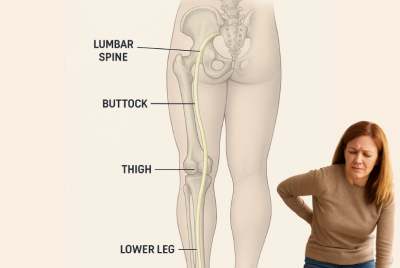Is Sciatica a Disability
Discover if sciatica qualifies as a disability and get expert insights on managing it. Is sciatica a disability? Find out here. Sciatica is a common and often debilitating condition that affects millions of people worldwide. If you’re one of the many individuals grappling with sciatica, you might be wondering, “Is sciatica a disability?” In this article, we will explore sciatica, its impact on daily life, and whether it qualifies as a disability. We’ll also provide helpful suggestions for those navigating this challenging condition.
Understanding the Causes of Sciatica
Before delving into the question of disability, let’s first understand what sciatica is and what causes it.
Herniated Disc
One of the primary causes of sciatica is a herniated disc. This occurs when the soft inner material of a spinal disc protrudes through the tougher outer layer, putting pressure on the nearby sciatic nerve.
Spinal Stenosis
Spinal stenosis, the narrowing of the spinal canal, can also lead to sciatica symptoms. The constriction in the spinal canal can compress the sciatic nerve, causing pain and discomfort.
Piriformis Syndrome
Piriformis syndrome is another condition that can mimic sciatica. It involves the piriformis muscle in the buttocks, irritating or compressing the sciatic nerve.
Symptoms of Sciatica
Sciatica is characterized by a range of symptoms that can vary in intensity from person to person. Common symptoms include:
Radiating Pain: Many individuals with sciatica experience a sharp, shooting pain that radiates down one leg, following the path of the affected nerve.
Numbness and Tingling: Sciatica can cause numbness and tingling sensations in the leg or foot, making it challenging to walk or stand for extended periods.
Muscle Weakness: Some people with sciatica notice muscle weakness in the affected leg, which can affect their mobility.
Diagnosing Sciatica
Diagnosing sciatica involves a combination of medical history, physical examination, and sometimes, imaging tests.
Medical History
A thorough medical history helps doctors understand the patient’s symptoms and any underlying conditions that may contribute to sciatica.
Physical Examination
During a physical examination, healthcare providers may conduct reflex and muscle strength tests to identify signs of sciatica.
Imaging Tests
Imaging tests such as X-rays, MRI scans, or CT scans may be ordered to visualize the spinal structures and confirm the presence of sciatica.
Living with Sciatica
Living with sciatica can be challenging, but there are ways to manage it effectively:
Pain Management
Pain relief options include over-the-counter medications, prescription drugs, physical therapy, and, in some cases, epidural steroid injections.
Active pain management strategies are crucial for individuals dealing with sciatica. They need to take an active role in finding effective solutions to alleviate the discomfort and regain control of their lives. Pain management options may include over-the-counter medications, prescribed drugs, physical therapy, and, in some cases, epidural steroid injections. By actively engaging in pain management, individuals can better cope with the challenges posed by sciatica, improve their comfort, and enhance their overall well-being.
Physical Therapy
Physical therapy exercises can strengthen the back and leg muscles, reducing the risk of sciatica flare-ups. Engaging in active physical therapy is a vital component of sciatica management. Individuals must actively participate in exercises and sessions aimed at strengthening back and leg muscles, improving flexibility, and reducing pain. Physical therapists guide patients through tailored routines, emphasizing the importance of regular practice and active involvement. By actively engaging in physical therapy, individuals can enhance their mobility, alleviate sciatica symptoms, and regain their ability to perform daily activities with greater comfort and ease.
Lifestyle Changes
Simple lifestyle changes like maintaining proper posture, engaging in regular exercise, and managing body weight can alleviate sciatica symptoms. Lifestyle changes play a pivotal role in managing sciatica. Individuals need to actively participate in these adjustments to alleviate symptoms and improve their quality of life. These changes often include maintaining proper posture, engaging in regular exercise to strengthen back and leg muscles, and managing body weight to reduce pressure on the sciatic nerve. By making these lifestyle changes, individuals can take an active role in their recovery and minimize the impact of sciatica on their daily lives.
Is Sciatica a Disability?
The question of whether sciatica is a disability hinges on several factors.
Legal Definition of Disability
Legally, a disability is a condition that significantly impairs a person’s ability to perform daily activities and work. Sciatica can meet this criterion for some individuals.
Impact of Sciatica on Daily Life
Sciatica significantly impacts daily life for those affected. The condition causes radiating pain, often sharp and severe, making simple activities like walking, sitting, or standing difficult. Numbness and tingling sensations can hinder mobility, affecting one’s independence. Muscle weakness in the affected leg further limits physical capabilities. The active voice highlights how sciatica directly affects individuals, emphasizing the challenges it presents. Coping strategies, medical treatments, and lifestyle adjustments become essential for those dealing with the day-to-day consequences of sciatica to regain functionality and improve their quality of life.
Applying for Disability Benefits
If you find that sciatica has become a disability for you, you may consider applying for disability benefits.
Social Security Disability Insurance (SSDI)
SSDI provides financial assistance to those who have paid into the Social Security system and meet specific criteria for disability.
Supplemental Security Income (SSI)
SSI offers support to disabled individuals with limited income and resources.
Tips for Navigating the Disability Application Process
Navigating the disability application process can be complex, but there are some tips that can help streamline it:
Seek Professional Help: Consulting with a disability attorney or advocate can increase your chances of a successful application.
Gather Medical Records: Ensure you have thorough medical records documenting your sciatica and its impact on your daily life.
Be Patient: The application process can take time, and it may involve appeals if your initial claim is denied.
Coping with the Emotional Impact
Dealing with sciatica-related disability can be emotionally taxing. It’s essential to seek support from friends, family, or mental health professionals to help cope with the challenges.
Frequently Asked Questions (FAQs)
Is sciatica a lifelong condition?
Sciatica’s duration varies among individuals. While some may experience it as a temporary issue caused by a specific injury, for others, it can become a lifelong condition. The severity, underlying causes, and effectiveness of treatments all play a role in determining whether sciatica persists long-term. Seeking medical advice and adopting appropriate management strategies is crucial for improving one’s quality of life when dealing with this condition.
How long does sciatica take to fully heal?
The duration for sciatica to fully heal varies. Recovery depends on factors like the cause, treatment, and individual response. Some experience relief in a matter of weeks, while others may take several months. Active participation in prescribed treatments, physical therapy, and lifestyle adjustments can expedite healing. Consulting a healthcare professional for personalized guidance is essential in this process.
Does sciatica qualify for short term disability?
Sciatica may qualify for short-term disability benefits depending on the severity and duration of the condition. Employers and insurance providers typically have specific policies regarding eligibility for short-term disability. Individuals experiencing sciatica should consult their employer’s human resources department and review their insurance policy to determine if they meet the criteria for short-term disability coverage.
What is the best scan for sciatica?
The best scan for diagnosing sciatica is typically an MRI (Magnetic Resonance Imaging). An MRI provides detailed images of the spine, allowing healthcare professionals to visualize any abnormalities, such as herniated discs or spinal stenosis, that may be compressing the sciatic nerve. It offers high sensitivity and specificity, aiding in accurate diagnosis and treatment planning for sciatica.
What makes sciatica worse?
Sciatica worsens due to various factors. Physical activities, such as lifting heavy objects incorrectly, can exacerbate symptoms. Prolonged sitting or standing, poor posture, and obesity also contribute. Additionally, underlying causes like herniated discs or spinal stenosis can worsen over time. Proper diagnosis, treatment, and lifestyle adjustments are vital in managing and mitigating the factors that exacerbate sciatica.
Extra FAQs Related to Is Sciatica a Disability
Is sciatica always considered a disability?
No, sciatica is not always considered a disability. Whether it qualifies as a disability depends on the individual’s specific circumstances and the extent to which it impairs their daily life.
Can I work with sciatica?
It is possible to work with sciatica, but it may require adjustments in your job tasks, accommodations, and pain management strategies. Some people with sciatica continue to work, while others may need disability benefits.
How long does it take to receive disability benefits for sciatica?
The time it takes to receive disability benefits for sciatica can vary. It typically involves a review process, and the duration depends on factors such as the severity of your condition and the efficiency of the application process.
Are there any alternative treatments for sciatica?
Yes, there are alternative treatments for sciatica, including physical therapy, chiropractic care, acupuncture, and yoga. These therapies can complement traditional medical treatments.
Can sciatica-related disability be temporary?
In some cases, sciatica-related disability may be temporary, especially if it’s caused by a specific injury that heals over time. However, for others, it can be a chronic condition that requires ongoing management.
Is Sciatica a Disability – Conclusion
In conclusion, we firmly establish that sciatica can indeed be considered a disability for many individuals. It significantly impairs daily activities, ranging from walking to sitting, causing excruciating pain and discomfort. The active voice in this context emphasizes that sciatica imposes these limitations, affecting both work and personal life. For those grappling with this condition, seeking disability benefits, such as Social Security Disability Insurance (SSDI) or Supplemental Security Income (SSI), becomes a valid option to secure necessary financial support. While the journey of coping with sciatica-related disability may be challenging, remember that there is hope, professional assistance available, and numerous ways to enhance your quality of life despite the obstacles presented by sciatica.
Disclaimer
Please note that this article should not replace professional medical or legal advice. Consult a healthcare and legal professional for an accurate diagnosis and tailored treatment plan.





